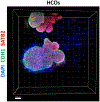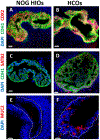Generation of human colonic organoids from human pluripotent stem cells
- PMID: 32586443
- PMCID: PMC8488951
- DOI: 10.1016/bs.mcb.2020.03.001
Generation of human colonic organoids from human pluripotent stem cells
Abstract
Advances in human pluripotent stem cell (hPSC) biology now allow the generation of organoids that resemble different regions of the gastrointestinal tract. Generation of region-specific organoids has been facilitated by developmental biology studies carried out in model organisms such as mouse, frog and chick. By mimicking embryonic development, hPSC-derived human colonic organoids (HCOs) can be generated through a stepwise differentiation, first into definitive endoderm (DE), then into mid/hindgut spheroids which are then patterned into posterior gut tissue which gives rise to HCOs following prolonged in vitro culture. HCOs undergo transitions similar to those observed in the developing colon of model organisms and human embryos. HCOs develop into tissue that resembles fetal colon on the basis of morphology, gene expression and presence of differentiated cell types. Generation of HCOs without the proper training or expertise can be a daunting task. Here, we describe a detailed protocol for differentiating hPSCs into HCOs, we include suggestions for troubleshooting these differentiations, and we discuss experimental design considerations. We have also highlighted the key advantages and limitations of the system.
Keywords: Definitive endoderm; Hindgut; Human colonic organoid; Human pluripotent stem cells.
© 2020 Elsevier Inc. All rights reserved.
Figures






Similar articles
-
Generation of Gastrointestinal Organoids from Human Pluripotent Stem Cells.Methods Mol Biol. 2017;1597:167-177. doi: 10.1007/978-1-4939-6949-4_12. Methods Mol Biol. 2017. PMID: 28361317
-
Differentiation of Human Pluripotent Stem Cells into Colonic Organoids via Transient Activation of BMP Signaling.Cell Stem Cell. 2017 Jul 6;21(1):51-64.e6. doi: 10.1016/j.stem.2017.05.020. Epub 2017 Jun 22. Cell Stem Cell. 2017. PMID: 28648364 Free PMC article.
-
Generation, Maintenance, and Characterization of Human Pluripotent Stem Cell-derived Intestinal and Colonic Organoids.J Vis Exp. 2021 Jul 9;(173). doi: 10.3791/62721. J Vis Exp. 2021. PMID: 34309606
-
Modeling endodermal organ development and diseases using human pluripotent stem cell-derived organoids.J Mol Cell Biol. 2020 Aug 1;12(8):580-592. doi: 10.1093/jmcb/mjaa031. J Mol Cell Biol. 2020. PMID: 32652003 Free PMC article. Review.
-
A critical look: Challenges in differentiating human pluripotent stem cells into desired cell types and organoids.Wiley Interdiscip Rev Dev Biol. 2020 May;9(3):e368. doi: 10.1002/wdev.368. Epub 2019 Nov 19. Wiley Interdiscip Rev Dev Biol. 2020. PMID: 31746148 Free PMC article. Review.
Cited by
-
Elucidation of the Pathogenesis of Autoinflammatory Diseases Using iPS Cells.Children (Basel). 2021 Feb 1;8(2):94. doi: 10.3390/children8020094. Children (Basel). 2021. PMID: 33535645 Free PMC article. Review.
-
Effect of Valproic Acid on Promoting the Differentiation of Human Embryonic Stem Cells Into Cholangiocyte-Like Cells.Stem Cells Transl Med. 2024 Feb 14;13(2):166-176. doi: 10.1093/stcltm/szad079. Stem Cells Transl Med. 2024. PMID: 37995322 Free PMC article.
-
Recent advances and challenges in colorectal cancer: From molecular research to treatment.World J Gastroenterol. 2025 Jun 7;31(21):106964. doi: 10.3748/wjg.v31.i21.106964. World J Gastroenterol. 2025. PMID: 40538516 Free PMC article. Review.
-
Tumor organoid model of colorectal cancer (Review).Oncol Lett. 2023 Jun 15;26(2):328. doi: 10.3892/ol.2023.13914. eCollection 2023 Aug. Oncol Lett. 2023. PMID: 37415635 Free PMC article. Review.
-
Coordinated differentiation of human intestinal organoids with functional enteric neurons and vasculature.Cell Stem Cell. 2025 Apr 3;32(4):640-651.e9. doi: 10.1016/j.stem.2025.02.007. Epub 2025 Mar 4. Cell Stem Cell. 2025. PMID: 40043706
References
MeSH terms
Grants and funding
LinkOut - more resources
Full Text Sources

